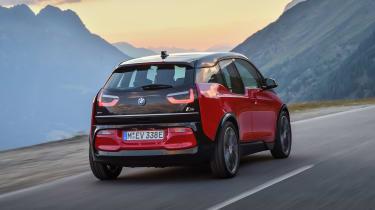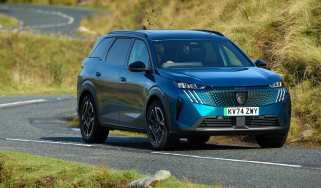BMW i3 (2013-2022) review
The BMW i3 was one of the first electric cars to make everyday drivers sit up and take notice, with its cool styling, decent handling and useful range
Pros
- Fun to drive
- Futuristic styling inside and out
- Uses eco-conscious materials
Cons
- Pricey compared to rivals
- Range is no longer competitive
- Compact interior and small boot
| Model | Range | Wallbox charge time | Rapid charge time |
|---|---|---|---|
| i3 | 189 miles | 6hrs 15mins (7.4kW, 0-100%) | 36mins (50kW, 10-80%) |
| i3s | 175 miles | 6hrs 15mins (7.4kW, 0-100%) | 36mins (50kW, 10-80%) |
If you’re looking for an electric car to get you from A to B, there are plenty of options, from the Vauxhall Corsa-e and Peugeot e-208 to the Renault ZOE and Fiat 500. All these small electric cars offer greater driving range at a lower price than the BMW i3 – mainly as they use more up-to-date technology.
But where those cars stick to simple formulas and some share platforms, bodies and interior cues with petrol-powered counterparts, the i3's unique styling, advanced carbon-fibre construction and prestigious badge all set it apart. Much like the Honda e, the i3 assumes that, far from being fearful of electric technology, buyers will want to make a statement about their decision to switch to zero-emissions.
The i3 certainly does that, and so futuristic does it feel that it's hard to believe it's now a discontinued model. It was first unveiled in concept form at the Frankfurt Motor Show in 2011 and went on sale in the UK in 2013. It became one of the 10 best-selling electric cars in the world, alongside the Nissan Leaf, Tesla Model 3 and Tesla Model S, before production came to an end in June 2022.
BMW’s compact electric car is a five-door hatchback, like the ZOE and Honda e. However, the way it has been designed, constructed and packaged gives it a different feel to anything else on the road. The body is made of carbon-fibre clad in plastic panels, while a high roofline and rear-hinged back doors maximise practicality. The design stands out in traffic, too, thanks to clever detailing and interesting side-window profiles. Inside, the futuristic interior has a boutique feel thanks to its eco-friendly yet luxurious finish.
As a pure-electric vehicle, there’s no engine compartment as such; the i3 features a 168bhp electric motor driving the rear axle via a single-speed automatic transmission, with the batteries located under the floor. The i3s is the more performance-focused variant, with a 180bhp motor; official ranges from a fully charged battery are 189 and 175 miles respectively.
Real-world range in our experience is just over 160 miles, but it depends very much on your driving style and the prevailing road conditions. It takes almost 20 hours to fully charge the i3's batteries from a standard three-pin socket. However, if you fit a 7kW wallbox charger at home, you can reduce that to six hours. If you use a rapid charger at motorway services or elsewhere, it'll take some 30 minutes to add 100 miles of range.
The two versions of the i3 are similarly well equipped, with both getting LED headlamps and big alloy wheels, BMW's iDrive infotainment system with DAB radio, Bluetooth connectivity and automatic headlamps and wipers. The i3s gives you the punchier motor, but also has 20-inch alloys instead of the standard 19-inch rims, plus lower sports suspension, sharper steering, optimised traction control and a 'Sport' driving mode.
On the road, the i3 is fun, with responsive acceleration, crisp steering and near-silent running making it effective at darting around town. Ride quality isn't brilliant, though, and the short-travel suspension means hustling the car along country roads can fairly quickly become unsettling. Body control and handling improve a little with the upgraded suspension of the i3s, but don’t think this is an electric hot hatchback – it’s not.
The i3 feels most at home around town and in the suburbs, which isn’t such a bad thing when you consider its primary role is as a second car for many families. Practicality is compromised by a smallish boot that only offers 260 litres of luggage space with all seats in place, and by the fact that you only get a two-seat rear bench. But if you can live with those restrictions, the BMW is a fun-to-drive, cheap-to-run, stylish and eco-friendly lifestyle statement. For a more detailed look at the i3, read on for the rest of our in-depth review...



